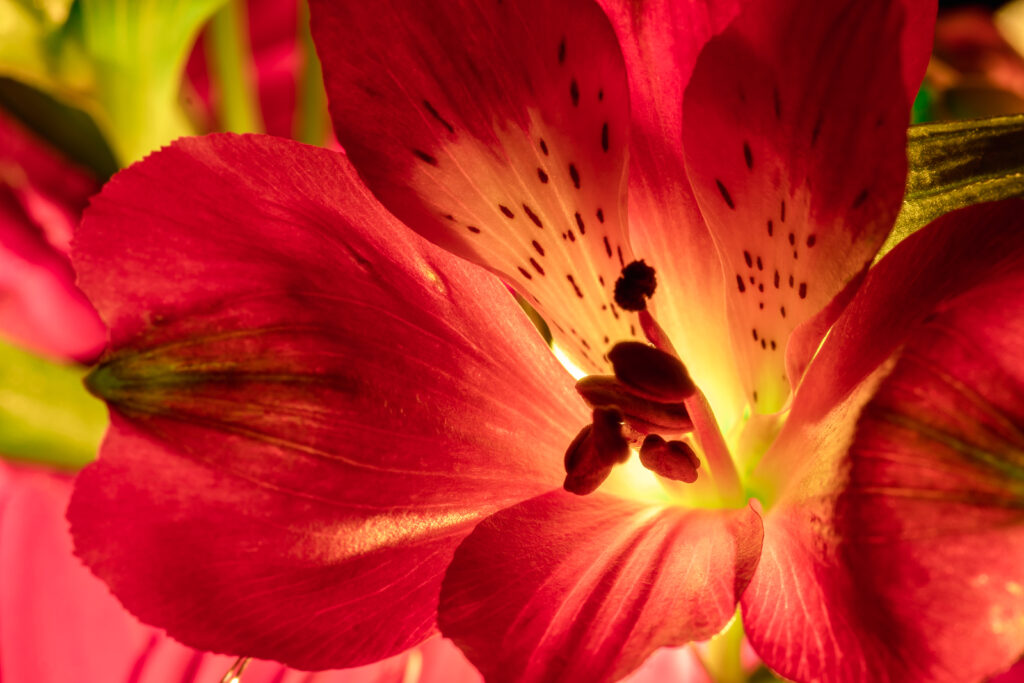Alstroemeria–commonly called Peruvian Lily–produces large clusters of brilliant-colored azalea like flowers. Colors range from hot to red and pink to cool mauve and purple. Peruvian lilies are often massed in groups or mixed borders.
Alstromeria is a genus of South American plants, members of the Amaryllis family that grow from tuberous roots are treated like bulbs.
They require deep planting in deep rich soil. They are commonly planted in a moist, fairly sunny spot. They can be brought indoors when cool weather comes.
Whether grown in pots or in the soil the tuberous roots need dividing once a year. Alstromeria can be grown from fresh seed sown in late summer or later in pots. Seed sown in autumn will bloom the following summer.

Get to know Alstroemeria
- Plant type: Tuberous perennial often grown as an annual
- Growing Zones and range: Zones 6-10
- Hardiness: Tender perennial bulb; the plant will die back when hit by frost; tubers can tolerate frozen soil; tubers are hardy to 0°F (-18°C).
- Height and width: 2 to 3 feet tall (60-90cm); 24 inches (60cm) wide
- Foliage: Gray-green leaves are narrow and pointed; plants form thick, fibrous roots
- Flowers: Loose clusters of trumpet-shaped flowers
- Flower color: Clusters of mottled hot red, salmon, pink, gold, orange, and yellow flowers. Also, clusters or cool mauve, lavender, purple, cream, and white blooms.
- Bloom time and color: Blooms late spring to late summer.
- Uses: Very good cutting flower; mass in groups in flower beds, borders, and meadows, also containers.
- Common name: Peruvian lily, Inca lily
- Botanical name: Alstroemeria spp.
- Family: Liliaceae
- Origin: South America

Where to plant Alstroemeria
- Grow Alstroemeria in full sun in Zones 6-7 and Pacific Northwest. Grow in part shade in warm and hot summer regions.
- Plant Alstroemeria in well-drained, acidic to neutral soil.
- Alstroemeria grows the best in slightly acid to neutral soil.
Alstromeria uses and companions
- Plant Alstromeria in an informal landscape, meadow, or cottage garden; Altromeria can become invasive to give it room to roam.
- Alstromeria dies back in late summer so fill the space with annuals.
- Companions include Achillea millefolium and ‘Moonshine’, Coreopsis, Felicia amelloides.
When to plant Alstroemeria
- Set Alstroemeria rhizomes in the garden in early spring in all Zones; in Zones 8-10 plant in fall.
- Sow seeds outdoors in early spring; plants started from seed require two years to reach maturity and produce flowers.
- Set plants started indoors or purchased in containers in the garden after the last frost in spring.

Planting and spacing Alstroemeria
- Sow seed 1/4 inch deep, 1 inch (2.5cm) apart; to speed germination soak seeds in water overnight before planting.
- Plant Alstroemeria rhizomes 6 to 8 inches(15-20cm) deep and 12 inches (30cm) apart in early spring. Cultivate the planting bed to 15 inches (38cm) deep before planting. Sprinkle bone meal in the planting hole before planting.
- Once rhizomes are planted do not disturb them for several years.
How to water and feed Alstroemeria
- Alstroemeria grows best in soil that is evenly moist.
- Apply a slow-release fertilizer to the planting bed in spring.
Alstroemeria care
- Add aged compost and slow-release fertilizer to planting beds in spring.
- Cover rhizomes with 3-inches (7.6cm) of mulch in autumn to protect roots through winter in Zone 7. In Zone 6 and cooler, dig up and store rhizomes in winter.
- Alstroemeria have no serious pests or diseases.

How to pick Alstroemeria flowers
- Do not cut Alstroemeria flowers. Grasp each stem several inches above the soil and gently twist it upwards; the stem will break cleanly from the base. This method of taking flowers encourages new bud growth and flowering.
Alstroemeria propagation
- Alstroemeria is propagated by seed or rhizome division.
- Divide clumps in early spring or fall; dig up a section of root leaving the rest intact.
- Be careful when dividing, roots are brittle.
- Sow seeds indoors after 4 to 6 weeks of cold (35°F/4°C) stratification outdoors or in the refrigerator.
Alstroemeria varieties to grow
- Alstromeria aurantica grows to nearly 4 feet (1.2m) tall; it has vibrant orange and yellow blooms; it is one of the hardiest alstromerias. Cultivars include ‘Orange King’ has orange-yellow flowers with brown spots, ‘Lutea’ has yellow flowers, ‘Splendens’ has red flowers.
- A. ligtu is a vigorous grower with mostly red flowers.
- A. pelegrina, Lily of the Incas, has spotted lilac-and-red flowers or white flowers; winter hardy.















